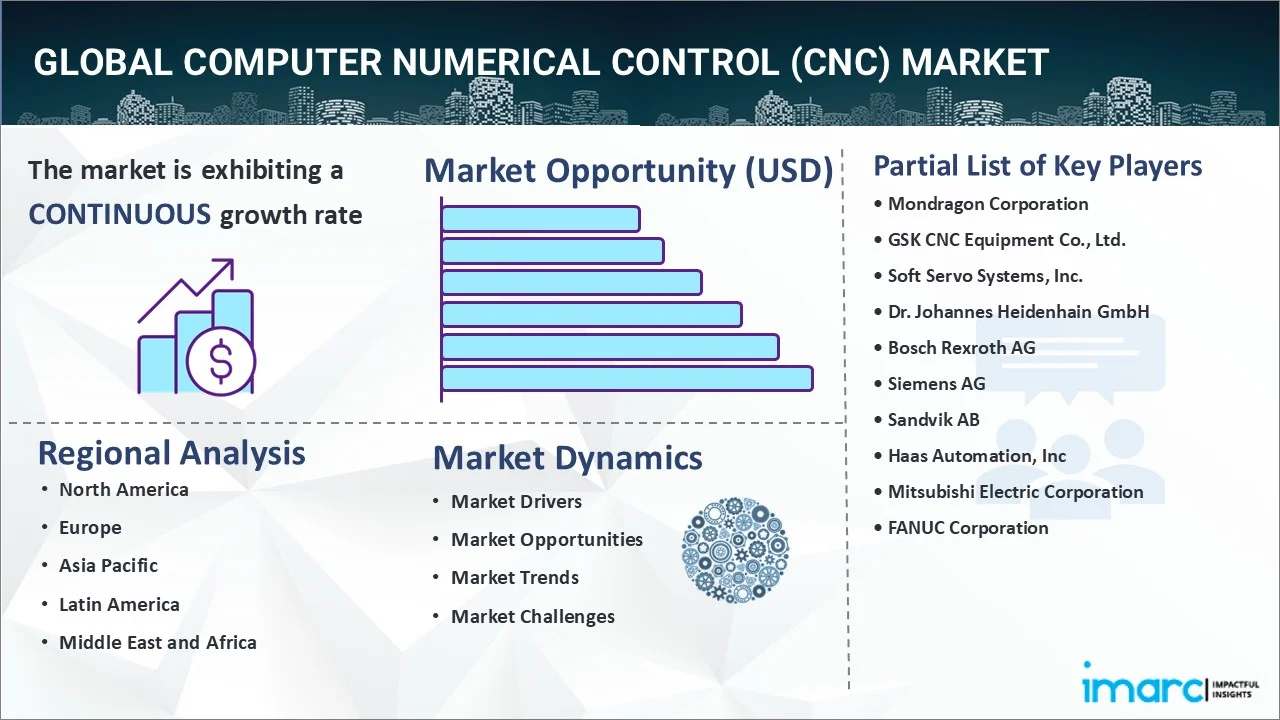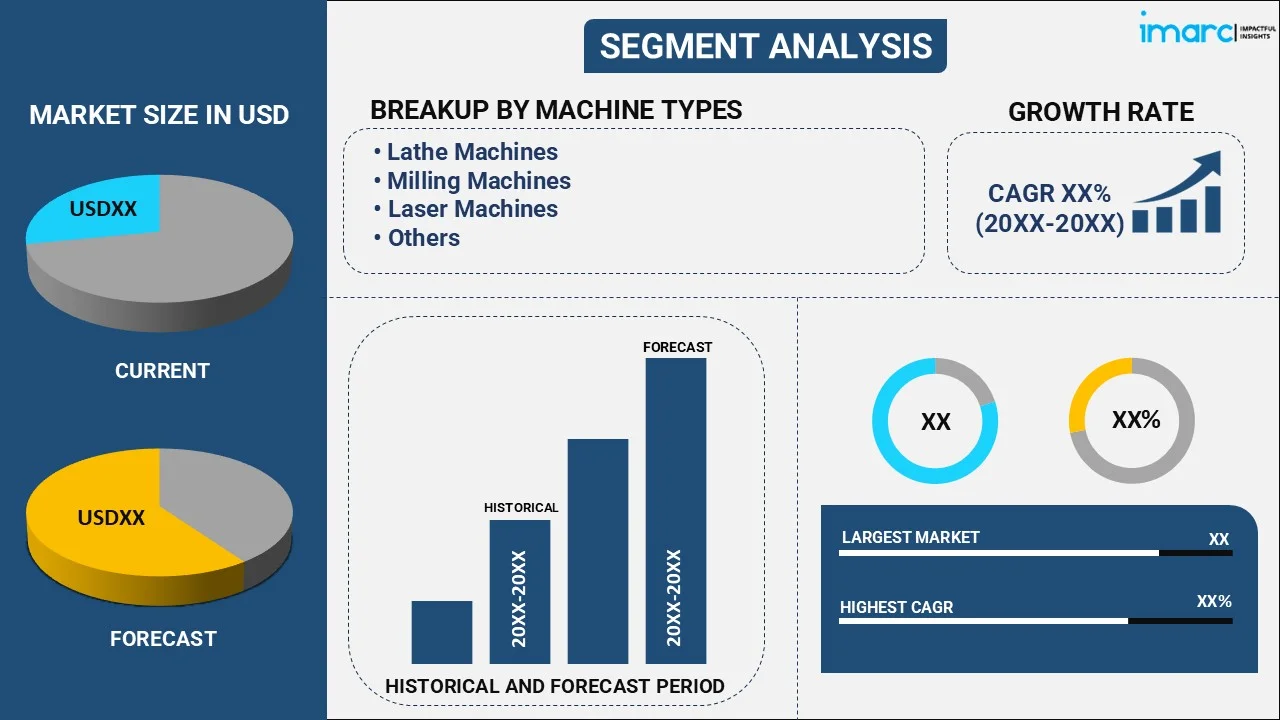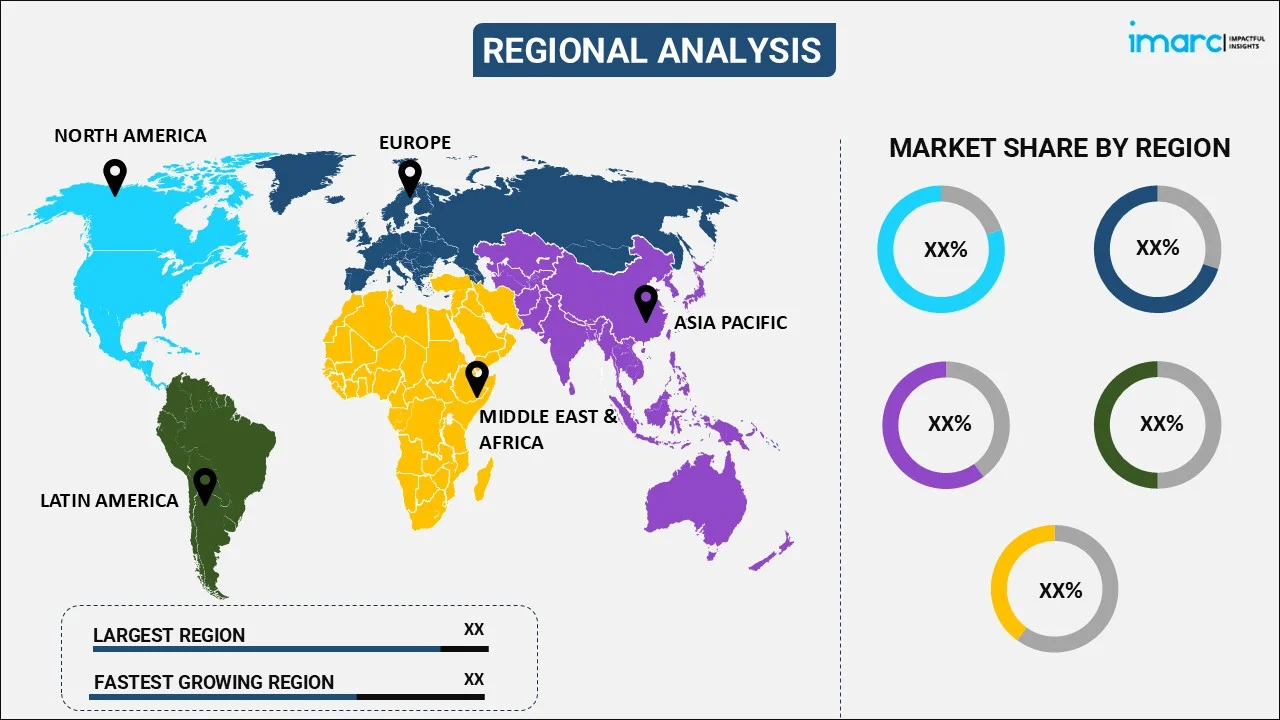
Computer Numerical Control (CNC) Market Report by Machine Type (Lathe Machines, Milling Machines, Laser Machines, Grinding Machines, Welding Machines, Winding Machines, and Others), End Use Industry (Aerospace and Defense, Automobile, Electronics, Healthcare, and Others), and Region 2025-2033
Market Overview:
The global computer numerical control (CNC) market size reached USD 90.5 Billion in 2024. Looking forward, IMARC Group expects the market to reach USD 144.4 Billion by 2033, exhibiting a growth rate (CAGR) of 5.06% during 2025-2033. The growing utilization in additive manufacturing, technological advancements, and rising demand from small scale industry represent some of the key factors driving the market.
|
Report Attribute
|
Key Statistics
|
|---|---|
|
Base Year
|
2024
|
|
Forecast Years
|
2025-2033
|
|
Historical Years
|
2019-2024
|
|
Market Size in 2024
|
USD 90.5 Billion |
|
Market Forecast in 2033
|
USD 144.4 Billion |
| Market Growth Rate 2025-2033 | 5.06% |
Technological Advancements Augmenting Market Growth
The introduction of various technologies currently represents one of the primary drivers contributing to the growth of the computer numerical control (CNC) market. The emergence of 4,5, and 6-axis machining in CNC provides high accuracy, better designs, and enhanced surface finish. Besides this, key players are introducing virtual reality in CNC that can be controlled by operators with the movement of the body part. Moreover, the rising utilization of three-dimensional (3D) cams technology for better monitoring of processes as compared to two-dimensional (2D) cams is propelling the growth of the market.

Competitive analysis such as market structure, market share by key players, player positioning, top winning strategies, competitive dashboard, and company evaluation quadrant has been covered in the report. Also, detailed profiles of all major companies have been provided. The market structure is fragmented with a large number of players operating in the industry across the globe. In addition, the volume of new entrants is low in the computer numerical control (CNC) industry due to low product differentiation, as the products available in the market are somewhat similar to one another. Besides this, high capital costs and high exit barriers act as a barrier for new entrants in the computer numerical control (CNC) market.
What is Computer Numerical Control (CNC)?
Computer numerical control (CNC) refers to a method designed to provide automated control of machines through programmed software that is embedded in a microcomputer attached to the tool. It is quick, accurate, scalable, precise, reduces energy consumption, and provides lower production costs while having low maintenance. It can produce complex parts, such as shaping, grinding, bending, cutting, welding, gluing, drilling, and hole punching of products efficiently as compared to manual machining. It assists in ensuring proper positioning and performance and consistent product quality, and manufacturing metal and plastic parts. It aids in minimizing the risk of human errors due to its reduced dependency on human labor, which decreases workforce requirements. It also helps in generating a computer-aided design (CAD) and translating it into G-code. Besides this, it is beneficial in providing enhanced safety and efficiency and increasing production while maintaining the uniformity of the product design. As a result, CNC is widely employed in the aerospace and defense, automobile, electronics, and healthcare industries around the world.
Computer Numerical Control (CNC) Market Trends:
At present, the increasing utilization of CNC in the aerospace and defense industry for complex airframe alignment tooling, robot control, additive machining, fiber placement and tape laying, and 5-axis machining represents one of the key factors impelling the growth of the market. Besides this, the growing adoption of CNC in additive manufacturing processes, such as milling, grinding, drilling, and polishing, on account of its automated precision efficiency, is positively influencing the market. Additionally, the rising utilization of CNC in manufacturing several automotive components, such as windscreens, outer body sheets, door panels, and various internal components, across the globe is bolstering the growth of the market. Apart from this, numerous benefits offered by CNC, such as high speed and efficient production, low maintenance, high accuracy, and reduced overall operational cost, are propelling the growth of the market. In addition to this, the rising demand for CNC among small and medium-scale enterprises (SMEs) around the world due to enhanced product quality is contributing to the growth of the market. Moreover, governing agencies of several countries are encouraging the adoption of CNC in several manufacturing units, which is offering a favorable market outlook. In line with this, numerous technological advancements in CNC, such as the introduction of three-dimensional (3D) cam technology for improved monitoring processes as compared to two-dimensional (2D) cams, is supporting the growth of the market. Furthermore, the increasing emergence of the internet of things (IoT), machine learning (ML), and big data solutions in CNC to reduce human errors and increase productivity is offering lucrative growth opportunities to industry investors.
Key Market Segmentation:
IMARC Group provides an analysis of the key trends in each sub-segment of the global computer numerical control (CNC) market report, along with forecasts at the global and regional level from 2025-2033. Our report has categorized the market based on machine type and end use industry.
Machine Type Insights:

- Lathe Machines
- Milling Machines
- Laser Machines
- Grinding Machines
- Welding Machines
- Winding Machines
- Others
The report has provided a detailed breakup and analysis of the computer numerical control (CNC) market based on the machine type. This includes lathe machines, milling machines, laser machines, grinding machines, welding machines, winding machines, and others. According to the report, lathe machines represent the largest segment, as they produce a high-quality product and assist in reducing time while increasing productivity rate. Additionally, there is a rise in the demand for lathe machines, as they can be easily set up and operated and provide accuracy and repeatability. In addition to this, the increasing adoption of lathe machines due to various benefits offered by them as compared to traditional lathes, such as multi-spindle, is impelling the growth of the market.
End Use Industry Insights:
- Aerospace and Defense
- Automobile
- Electronics
- Healthcare
- Others
A detailed breakup and analysis of the computer numerical control (CNC) market based on the end use industry has also been provided in the report. This includes aerospace and defense, automobile, electronics, healthcare, and others. According to the report, automobile accounted for the largest market, as CNC is widely utilized to produce various components, such as windscreen, outer body sheets, door panels, internal components, and assembly line manufacturing. Apart from this, there is a rise in the demand for high-performance, precision, and accuracy for faster production of components around the world. In line with this, various technological advancements in CNC, such as computer-aided design (CAD), computer-aided manufacturing (CAM), and software technology, in the automobile sector are bolstering the growth of the market.
Regional Insights:

- North America
- Asia Pacific
- Europe
- Middle East and Africa
- Latin America
The report has also provided a comprehensive analysis of all the major regional markets, which include North America, Asia Pacific, Europe, Middle East and Africa, and Latin America. According to the report, Asia Pacific was the largest market for computer numerical control (CNC). Some of the factors driving the Asia Pacific computer numerical control (CNC) market included the growing investments in the manufacturing sector, presence of many manufacturing units, and various technological advancements. In line with this, the rising adoption of CNC among the small and medium-sized enterprises (SMEs) is contributing to the growth of the market in the region.
Competitive Landscape:
The report has also provided a comprehensive analysis of the competitive landscape in the global computer numerical control (CNC) market. Some of the companies covered in the report include:
- MONDRAGON Corporation
- GSK CNC Equipment Co., Ltd.
- Soft Servo Systems, Inc.
- Dr. Johannes Heidenhain GmbH
- Bosch Rexroth AG
- Siemens AG
- Sandvik AB
- Haas Automation , Inc.
- Mitsubishi Electric Corporation
- FANUC Corporation
Please note that this only represents a partial list of companies, and the complete list has been provided in the report.
Report Coverage:
| Report Features | Details |
|---|---|
| Base Year of the Analysis | 2024 |
| Historical Period | 2019-2024 |
| Forecast Period | 2025-2033 |
| Units | Billion USD |
| Segment Coverage | Machine Type, End Use Industry, Region |
| Region Covered | Asia Pacific, Europe, North America, Latin America, Middle East and Africa |
| Companies Covered | Mondragon Corporation, GSK CNC Equipment Co., Ltd., Soft Servo Systems, Inc., Dr. Johannes Heidenhain GmbH, Bosch Rexroth AG, Siemens AG, Sandvik AB, Haas Automation, Inc., Mitsubishi Electric Corporation and FANUC Corporation |
| Customization Scope | 10% Free Customization |
| Post-Sale Analyst Support | 10-12 Weeks |
| Delivery Format | PDF and Excel through Email (We can also provide the editable version of the report in PPT/Word format on special request) |
Key Benefits for Stakeholders:
- IMARC’s report offers a comprehensive quantitative analysis of various market segments, historical and current market trends, market forecasts, and dynamics of the computer numerical control (CNC) market from 2019-2033.
- The research study provides the latest information on the market drivers, challenges, and opportunities in the global computer numerical control (CNC) market.
- The study maps the leading, as well as the fastest-growing, regional markets.
- Porter's five forces analysis assist stakeholders in assessing the impact of new entrants, competitive rivalry, supplier power, buyer power, and the threat of substitution. It helps stakeholders to analyze the level of competition within the computer numerical control (CNC) industry and its attractiveness.
- Competitive landscape allows stakeholders to understand their competitive environment and provides an insight into the current positions of key players in the market.
Key Questions Answered in This Report
The global computer numerical control (CNC) market was valued at USD 90.5 Billion in 2024.
We expect the global computer numerical control (CNC) market to exhibit a CAGR of 5.06% during 2025-2033.
The rising adoption of CNC process for large-scale automation setup as it promotes precision, contour machining, high speed production, and reduces the overall operational costs, is currently catalyzing the global computer numerical control (CNC) market.
The sudden outbreak of the COVID-19 pandemic has led to the increasing application of computer numerical control (CNC) machines to automate the bulk production process for various necessary healthcare equipment, while limiting the requirement of workers in a unit and maintaining social distancing.
Based on the machine type, the global computer numerical control (CNC) market has been segmented into lathe machines, milling machines, laser machines, grinding machines, welding machines, winding machines, and others. Currently, lathe machines hold the majority of the total market share.
Based on the end use industry, the global computer numerical control (CNC) market can be categorized into aerospace and defense, automobile, electronics, healthcare, and others. Among these, the automobile industry accounts for the largest market share.
On a regional level, the market has been classified into North America, Asia Pacific, Europe, Latin America, and Middle East and Africa, where Asia Pacific currently dominates the global market.
Some of the major players in the global computer numerical control (CNC) market include Mondragon Corporation, GSK CNC Equipment Co., Ltd., Soft Servo Systems, Inc., Dr. Johannes Heidenhain GmbH, Bosch Rexroth AG, Siemens AG, Sandvik AB, Haas Automation, Inc., Mitsubishi Electric Corporation and FANUC Corporation.
Need more help?
- Speak to our experienced analysts for insights on the current market scenarios.
- Include additional segments and countries to customize the report as per your requirement.
- Gain an unparalleled competitive advantage in your domain by understanding how to utilize the report and positively impacting your operations and revenue.
- For further assistance, please connect with our analysts.
 Inquire Before Buying
Inquire Before Buying
 Speak to an Analyst
Speak to an Analyst
 Request Brochure
Request Brochure
 Request Customization
Request Customization




.webp)




.webp)












